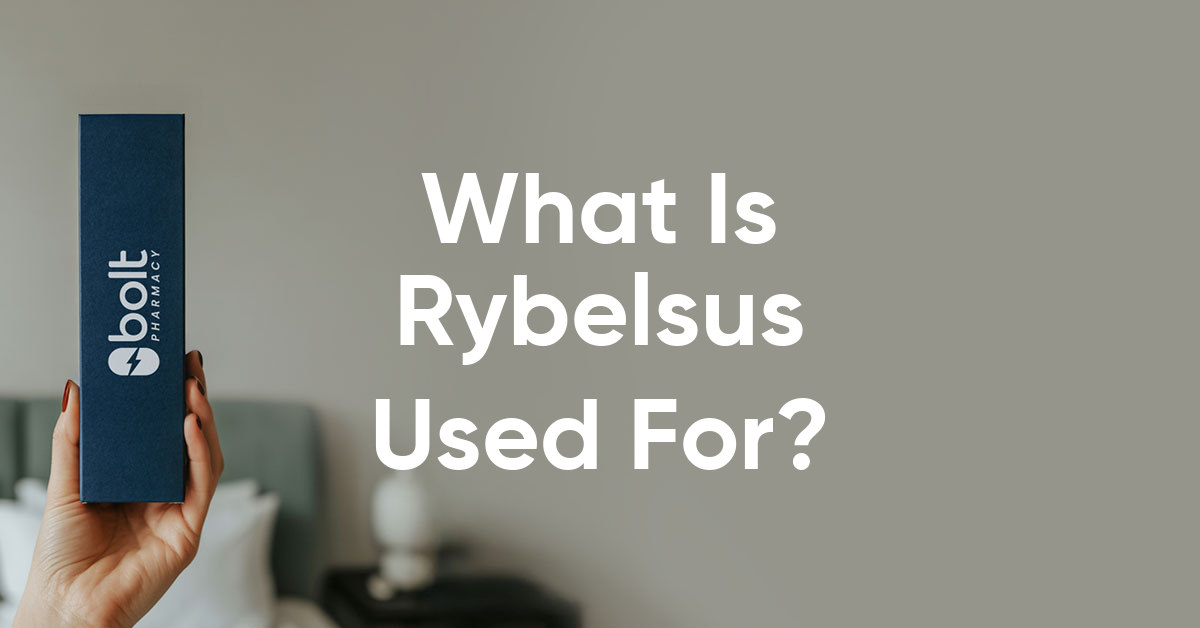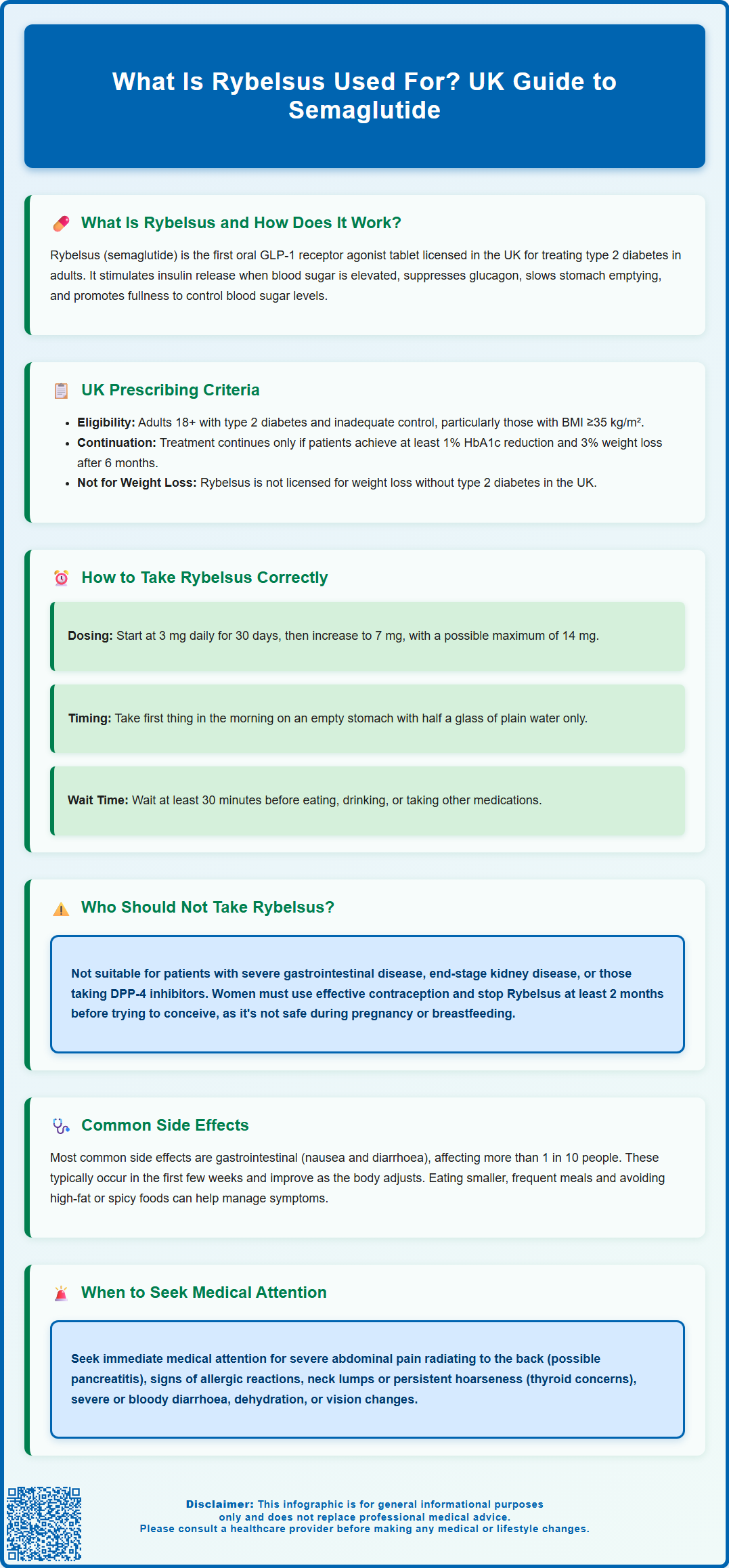Mounjaro®
Dual-agonist support that helps curb appetite, hunger, and cravings to drive substantial, sustained weight loss.
- ~22.5% average body weight loss
- Significant weight reduction
- Improves blood sugar levels
- Clinically proven weight loss

Rybelsus (semaglutide) is an oral medication licensed in the UK for treating type 2 diabetes mellitus in adults. As the first tablet-form GLP-1 receptor agonist, it offers an alternative to injectable diabetes treatments. Rybelsus works by mimicking a natural hormone that regulates blood sugar levels, stimulating insulin release when glucose is elevated and slowing digestion to reduce post-meal blood sugar spikes. It is prescribed to improve glycaemic control when diet and exercise alone are insufficient, typically alongside other diabetes medications such as metformin. Approved by the MHRA and available on NHS prescription, Rybelsus is not licensed for weight loss in the absence of type 2 diabetes.
Summary: Rybelsus is used to treat type 2 diabetes mellitus in adults by improving blood sugar control when diet and exercise alone are insufficient.
Rybelsus (semaglutide) is an oral medication licensed in the UK for the treatment of type 2 diabetes mellitus in adults. It belongs to a class of medicines called glucagon-like peptide-1 (GLP-1) receptor agonists, which mimic the action of a naturally occurring hormone that helps regulate blood sugar levels. Rybelsus is the first GLP-1 receptor agonist available in tablet form, offering an alternative to injectable formulations for patients who prefer oral therapy.
The primary indication for Rybelsus is to improve glycaemic control in adults with type 2 diabetes when diet and exercise alone are insufficient. It is typically prescribed alongside other glucose-lowering medications such as metformin, or as monotherapy when metformin is not tolerated or contraindicated. Importantly, Rybelsus is not licensed for weight loss in the absence of type 2 diabetes.
Mechanism of action: Semaglutide works by binding to GLP-1 receptors in the pancreas, which stimulates insulin secretion and suppresses glucagon release in a glucose-dependent manner—meaning it only triggers insulin release when blood sugar levels are elevated. This reduces the risk of hypoglycaemia compared to some other diabetes medications. Additionally, Rybelsus slows gastric emptying, which helps reduce post-meal blood sugar spikes, and acts on appetite centres in the brain to promote satiety, often leading to modest weight loss.
Clinical trials have demonstrated that Rybelsus effectively reduces HbA1c (a measure of long-term blood sugar control) and body weight in people with type 2 diabetes. The medication is approved by the MHRA and is available on NHS prescription for eligible patients meeting specific clinical criteria as outlined in NICE guidance.
Rybelsus is prescribed for adults aged 18 years and over with type 2 diabetes mellitus who require improved glycaemic control. It is not licensed for use in type 1 diabetes or for the treatment of diabetic ketoacidosis. The decision to prescribe Rybelsus is made by a healthcare professional following a comprehensive assessment of the patient's medical history, current diabetes management, and individual treatment goals.
Eligibility considerations: According to NICE guidance, GLP-1 receptor agonists like Rybelsus may be considered for patients who have not achieved adequate blood sugar control with other oral antidiabetic medications. They are typically recommended for patients with a BMI of 35 kg/m² or higher (adjusted for ethnicity), or for those with a BMI below 35 kg/m² where weight loss would benefit obesity-related comorbidities. Treatment should only be continued if there is an HbA1c reduction of at least 11 mmol/mol (1%) and weight loss of at least 3% from initial body weight after 6 months.
Important precautions: In animal studies, semaglutide has been associated with thyroid C-cell tumours, although the human relevance is unknown. Patients should be counselled to report symptoms such as a lump in the neck, persistent hoarseness, or difficulty swallowing.
Rybelsus is not recommended for use in patients with severe gastrointestinal disease, including severe gastroparesis. While no dose adjustment is required for renal impairment, there is limited experience in patients with end-stage renal disease, so caution is advised. Patients with a history of pancreatitis should be monitored closely.
Rybelsus should not be used during pregnancy or breastfeeding. Women of childbearing potential should use effective contraception during treatment and discontinue Rybelsus at least 2 months before a planned pregnancy. Concomitant use with DPP-4 inhibitors is not recommended in UK practice.
Patients with diabetic retinopathy should be monitored closely, as rapid improvements in glycaemic control have been associated with temporary worsening of this condition.
Before starting Rybelsus, your GP or diabetes specialist will review your full medical history, current medications, and conduct necessary blood tests to ensure the treatment is appropriate and safe for you.

Rybelsus tablets are available in three strengths: 3 mg, 7 mg, and 14 mg. The medication requires a specific administration technique to ensure optimal absorption, as semaglutide is a peptide that can be degraded in the stomach. Correct dosing and timing are essential for the medication to work effectively.
Starting dose and titration: Treatment typically begins with 3 mg once daily for the first 30 days. This initial dose is primarily for tolerability and is not expected to provide full glycaemic control. After 30 days, the dose is increased to 7 mg once daily. If additional blood sugar control is needed after at least 30 days on 7 mg, the dose may be increased to the maximum of 14 mg once daily. Dose escalation helps minimise gastrointestinal side effects.
Administration instructions:
Take Rybelsus first thing in the morning on an empty stomach.
Swallow the tablet whole with up to half a glass (120 ml) of plain water only—do not use other beverages, as they may reduce absorption.
Wait at least 30 minutes before eating, drinking, or taking other oral medications. This waiting period is crucial for proper absorption.
Do not split, crush, or chew the tablets.
If you miss a dose, skip it and take your next dose the following day—do not take two doses to make up for a missed one.
If you vomit shortly after taking Rybelsus, do not take an extra dose; take the next scheduled dose the following day.
Important considerations: Rybelsus should be stored below 30°C in the original blister pack to protect from moisture. Keep tablets out of reach of children.
If you take levothyroxine, your thyroid function should be monitored when starting Rybelsus. If you take warfarin or other coumarin derivatives, more frequent INR monitoring is recommended when beginning treatment.
If you find it difficult to adhere to the specific administration requirements, discuss with your healthcare provider whether an injectable GLP-1 receptor agonist might be more suitable for you.
Patients should maintain regular follow-up appointments to monitor HbA1c levels, weight, and any side effects. Your healthcare team will assess treatment response and determine whether dose adjustments are necessary.
Like all medications, Rybelsus can cause side effects, although not everyone experiences them. The most common adverse effects are gastrointestinal in nature and typically occur during the initial weeks of treatment or following dose increases. These effects often diminish over time as the body adjusts to the medication.
Very common side effects (affecting more than 1 in 10 people) include:
Nausea—often the most reported side effect, usually mild to moderate and improving with continued use
Diarrhoea—may occur particularly in the first few weeks
Common side effects (affecting up to 1 in 10 people) include:
Vomiting
Abdominal pain or discomfort
Decreased appetite—this is partly how the medication aids weight loss
Constipation
Dyspepsia (indigestion)
Managing gastrointestinal symptoms: Eating smaller, more frequent meals, avoiding high-fat or spicy foods, and staying well-hydrated can help reduce nausea and digestive discomfort. If symptoms are severe or persistent beyond the first few weeks, contact your GP, as dose adjustment or additional supportive treatment may be needed.
Less common but important side effects include:
Hypoglycaemia (low blood sugar)—more likely when Rybelsus is used with insulin or sulfonylureas. Symptoms include trembling, sweating, confusion, and rapid heartbeat. Patients should be educated on recognising and treating hypoglycaemia.
Gallstones—weight loss associated with GLP-1 therapy may increase risk.
When to seek medical attention: Contact your GP or seek urgent medical advice if you experience:
Severe, persistent abdominal pain (particularly radiating to the back)—this could indicate pancreatitis, a rare but serious side effect. If pancreatitis is suspected, discontinue Rybelsus and seek immediate medical attention.
Signs of allergic reaction (rash, swelling, difficulty breathing)
Symptoms of thyroid problems (lump in the neck, persistent hoarseness, difficulty swallowing)
Severe or bloody diarrhoea
Signs of dehydration due to vomiting or diarrhoea
Changes in vision, particularly if you have diabetic retinopathy
Most patients tolerate Rybelsus well, and the benefits in terms of improved blood sugar control and potential weight loss often outweigh the temporary gastrointestinal side effects. Regular monitoring and open communication with your diabetes care team ensure that any concerns are addressed promptly.
Suspected side effects can be reported to the MHRA Yellow Card Scheme at yellowcard.mhra.gov.uk.
No, Rybelsus is not licensed in the UK for weight loss in the absence of type 2 diabetes. It is specifically approved for improving glycaemic control in adults with type 2 diabetes mellitus.
Rybelsus begins lowering blood sugar levels within days, but the full therapeutic effect develops over several weeks. Treatment response is typically assessed after 6 months, when HbA1c reduction and weight loss are evaluated to determine whether to continue therapy.
Rybelsus must be taken on an empty stomach with plain water only because food, beverages other than water, and other medications significantly reduce its absorption. Waiting at least 30 minutes before eating or drinking ensures the medication is properly absorbed into the bloodstream.
The health-related content published on this site is based on credible scientific sources and is periodically reviewed to ensure accuracy and relevance. Although we aim to reflect the most current medical knowledge, the material is meant for general education and awareness only.
The information on this site is not a substitute for professional medical advice. For any health concerns, please speak with a qualified medical professional. By using this information, you acknowledge responsibility for any decisions made and understand we are not liable for any consequences that may result.
Lorem ipsum dolor sit amet, consectetur adipiscing elit, sed do eiusmod tempor incididunt ut labore et dolore magna aliqua. Ut enim ad minim veniam, quis nostrud exercitation ullamco laboris nisi ut aliquip ex ea commodo consequat. Duis aute irure dolor in reprehenderit in voluptate velit esse cillum dolore eu fugiat nulla pariatur.
Block quote
Ordered list
Unordered list
Bold text
Emphasis
Superscript
Subscript